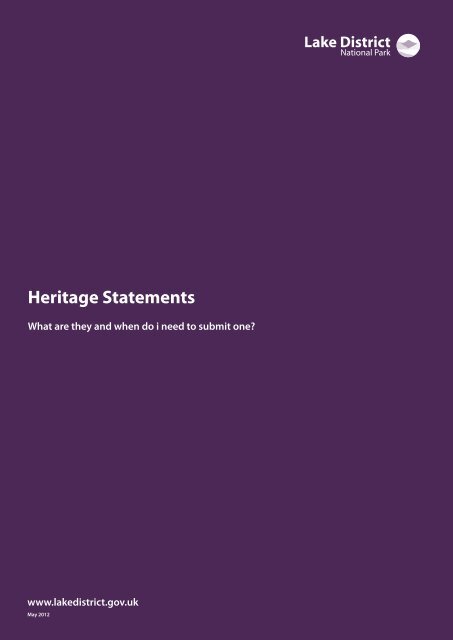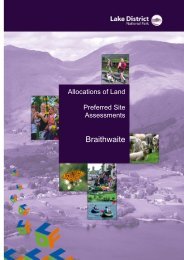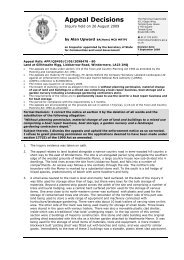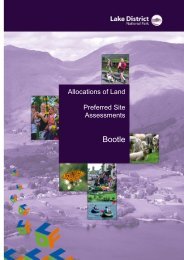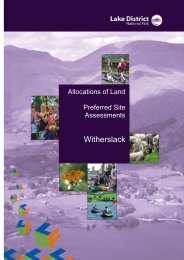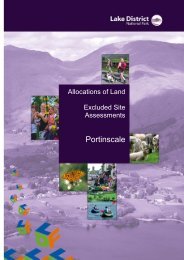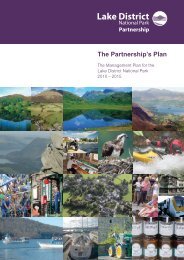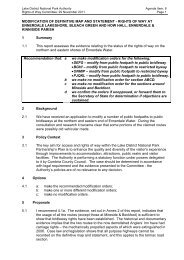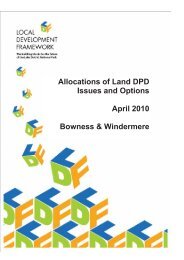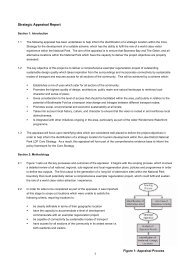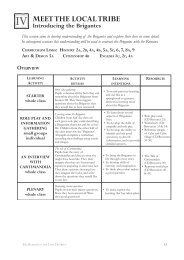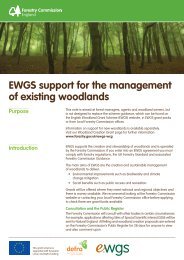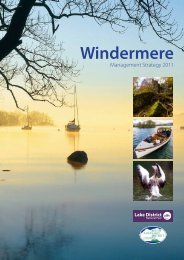Heritage statements guidance note (PDF) - Lake District National Park
Heritage statements guidance note (PDF) - Lake District National Park
Heritage statements guidance note (PDF) - Lake District National Park
You also want an ePaper? Increase the reach of your titles
YUMPU automatically turns print PDFs into web optimized ePapers that Google loves.
<strong>Heritage</strong> Statements<br />
What are they and when do i need to submit one?<br />
www.lakedistrict.gov.uk<br />
May 2012
Introduction<br />
<strong>Heritage</strong> Statements are required as part of the information submitted with planning related applications 1 when<br />
the proposed development might affect an archaeological site or historic building. The requirement for <strong>Heritage</strong><br />
Statements is included in the <strong>National</strong> Planning Policy Framework (the NPPF).<br />
What does the NPPF say?<br />
The <strong>National</strong> Planning Policy Framework sets out the Government’s policies on different aspects of spatial<br />
planning in England. The NPPF sets out planning policies on the conservation of the historic environment.<br />
Paragraph 128 of the <strong>National</strong> Planning Policy Framework states that:<br />
“In determining applications, local planning authorities should require an applicant to describe the significance<br />
of any heritage assets affected, including any contribution made by their setting. The level of detail should be<br />
proportionate to the assets’ importance and no more than is sufficient to understand the potential impact of<br />
the proposal on their significance. As a minimum the relevant historic environment record should have been<br />
consulted and the heritage assets assessed using appropriate expertise where necessary. Where a site on which<br />
development is proposed includes or has the potential to include heritage assets with archaeological interest,<br />
local planning authorities should require developers to submit an appropriate desk-based assessment and, where<br />
necessary, a field evaluation.”<br />
To meet the requirements of national planning policy we will expect applications affecting heritage assets to be<br />
accompanied by a heritage statement before we will consider the application.<br />
When are <strong>Heritage</strong> Statements needed?<br />
To ensure the requirements of the NPPF are met, we will require that a <strong>Heritage</strong> Statement is submitted before we<br />
validate applications the following types of application:<br />
• Applications for listed building consent<br />
• Applications within the curtilage of a listed building<br />
• Applications in Conservation Areas (including planning applications)<br />
• Applications affecting Scheduled Ancient Monuments 2<br />
• Applications affecting a Registered <strong>Park</strong> or Garden of Special Historic Interest;<br />
• Applications affecting an archaeological site.<br />
• Applications affecting unlisted buildings or structures identified by the LDNPA as heritage assets in the Local<br />
Development Framework<br />
What are <strong>Heritage</strong> Statements and <strong>Heritage</strong> Assets?<br />
A <strong>Heritage</strong> Statement outlines the significance of a heritage asset and the likely impact of proposed development<br />
upon that significance. <strong>Heritage</strong> assets are buildings, monuments, sites, places, areas or landscapes that are<br />
positively identified as having a degree of significance meriting consideration in planning applications. They are<br />
the valued components of the historic environment and include:<br />
• Designated assets (i.e. Scheduled Monuments, Listed Buildings, Registered <strong>Park</strong>s and Gardens of special<br />
historic interest, Conservation Areas);<br />
• Non-designated assets (eg. archaeological sites and historic buildings recorded in the <strong>Lake</strong> <strong>District</strong> Historic<br />
Environment Record; other historic assets identified by the LDNPA through the planning process).<br />
1<br />
applications for planning permission, listed building consent, or conservation area consent<br />
2<br />
these developments may also require Scheduled Monument Consent from English <strong>Heritage</strong><br />
www.lakedistrict.gov.uk
Can I write a <strong>Heritage</strong> Statement myself?<br />
Maybe. We need a <strong>Heritage</strong> Statement to be accurate and appropriate, but we will take a proportionate approach<br />
to what we expect depending on the scale and nature of the proposal and the heritage asset.<br />
Where a development is small and impacts are likely to be limited, a short heritage statement written by the<br />
applicant may well be adequate.<br />
In some cases though, the scale of the proposed development or the nature and importance of known heritage<br />
contractor. This will ensure that an appropriate statement is submitted. In such cases additional work may be<br />
required such as archaeological evaluation or analytical building survey. In these circumstances we may supply a<br />
brief outlining our requirements for the <strong>Heritage</strong> Statement.<br />
What will be in a <strong>Heritage</strong> Statement?<br />
The scope and degree of detail which is required in a <strong>Heritage</strong> Statement will vary according to the particular<br />
circumstances of each proposal. The statement should be proportionate to the situation. For example, a major<br />
produced heritage statement. A small-scale scheme which has only limited impacts meanwhile will probably only<br />
need a very short statement. There are however a number of basics which all <strong>Heritage</strong> Statements will need to<br />
cover.<br />
A <strong>Heritage</strong> Statement should always have three parts:<br />
heritage asset to this and future generations because of its heritage interest. That interest may be archaeological,<br />
architectural, artistic or historic).<br />
(2) Assessment of impact - an assessment of the likely impact of the proposed development on the heritage<br />
asset(s) and their setting.<br />
(3) Mitigation strategy - a statement outlining a mitigation strategy to address any impacts of the proposed<br />
design and/or archaeological or architectural investigation and recording.<br />
The<br />
thinks about what the relevant heritage asset is, and explains why the<br />
heritage asset is important. For example it may talk about what gives a Conservation Area its character, or discuss<br />
why a building has been listed.<br />
All heritage <strong>statements</strong> will include:<br />
•<br />
• Supporting information as necessary. Supporting information may include:<br />
o A location plan of suitable scale showing the site, its size, extent and context;<br />
o All necessary large scale existing plans, elevations, site levels, sections, context drawings and<br />
perspectives of the heritage asset, its setting and wider context;<br />
o Photographs, dated, numbered and cross-referenced to a plan;<br />
o Any available information from the <strong>Lake</strong> <strong>District</strong> Historic Environment Record;<br />
o Information from early maps.<br />
www.lakedistrict.gov.uk
•<br />
Schemes proposing major alterations or demolition of Listed Buildings and other historic buildings and structures<br />
- the following may be required:<br />
• A full analytical, architectural survey. This will need to be carried out to a brief supplied by the LDNPA.<br />
• Reference to the relevant conservation area appraisal and management plan where adopted;<br />
•<br />
and its setting;<br />
• Where demolition or substantial alteration is proposed, a full analytical, architectural survey to an agreed brief.<br />
and the impact of proposals.<br />
Writing your <strong>Heritage</strong> Statement - Assessment of Impact<br />
The Assessment of Impact<br />
the relevant heritage asset. For example this section may discuss how an extension to a property would impact<br />
All heritage <strong>statements</strong> will include:<br />
• A schedule of proposed works to the heritage asset and /or its setting;<br />
• All necessary large scale plans, elevations, sections, context drawings and perspectives which show the impact<br />
of the proposed works on the heritage asset, it setting and wider context;<br />
• A statement of impact assessing:<br />
•<br />
o<br />
o<br />
o<br />
should be applied.<br />
heritage asset;<br />
These should be prepared by a structural engineer and/or an Architect (both experienced in working with historic<br />
buildings), and identify, where appropriate:<br />
• the structural stability and condition of the asset, including any defects;<br />
• a schedule/method statement of proposed repairs;<br />
• a statement of how the stability of the structure and adjoining structures and their weather protection is to be<br />
safeguarded during the works;<br />
•<br />
works;<br />
• a statement identifying how the structure is to be safely demolished.<br />
www.lakedistrict.gov.uk
Area the following will be required:<br />
•<br />
•<br />
• A structural survey and method statement prepared by an engineer experienced in working with historic<br />
buildings. This should identify the structural stability and condition of the asset together with a statement<br />
identifying how the stability of the structure and adjoining structures is to be safeguarded during<br />
development or how the structure is to be safely demolished.<br />
and the impact of proposals.<br />
Writing your <strong>Heritage</strong> Statement - Mitigation Strategy<br />
The Mitigation Strategy explains what steps have been taken to avoid, minimise or mitigate any harm to<br />
A mitigation strategy should consider the following:<br />
• Minimal intervention and reversible works: Are all the works absolutely required for the proposed use or<br />
function? Can new work be designed so that it can easily be installed and removed at some later date without<br />
• Alternative methods of development: examining whether other options exist to meet the applicant’s<br />
objectives. Could a less sensitive part of the building be used to accommodate a proposed use or function?<br />
Could a new building or extension be repositioned so it is less detrimental to the setting of an archaeological<br />
feature or historic building?<br />
• Sensitive design: examples include the installation of new services in a discreet manner so as not to<br />
compromise the qualities of a room, or skilfully designing an extension that takes account of the physical<br />
massing and scale in both the old and the new work;<br />
• Choice of materials: the careful selection of construction materials for new and repair works can avoid both<br />
visual and longer-term structural harm to a building;<br />
• Recording: a programme for investigation and recording of architectural or archaeological features that would<br />
be obscured, damaged or destroyed.<br />
Identifying such approaches in your impact statement would help us to understand your design approach and<br />
www.lakedistrict.gov.uk
Useful sources of information<br />
There are a wide range of resources and further sources of information available to help you write your<br />
heritage statement:<br />
• The <strong>Lake</strong> <strong>District</strong> Historic Environment Record (LDHER) contains information on non-designated features,<br />
Listed Buildings and Registered <strong>Park</strong> and Gardens of Historic Interest. Information on Scheduled<br />
at http://www.heritagegateway.org.uk/gateway/<br />
• The <strong>National</strong> <strong>Heritage</strong> List for England provides details of: Listed Buildings; Scheduled Monuments;<br />
http://list.english-heritage.org.uk/<br />
• Conservation Area Appraisals and Management Plans - we have detailed appraisals for many of our<br />
Conservation Areas. The Appraisals identify which buildings within a conservation area make a positive<br />
as trees, landmarks, important views and the character of public and private open spaces. They can be<br />
downloaded from our website: http://www.lakedistrict.gov.uk/index/planning/conservation_areas<br />
• MAGIC is an interactive map service which brings together environmental information from across<br />
government. It includes information on Scheduled Monuments and many other types of designation:<br />
http://magic.defra.gov.uk/<br />
•<br />
in Kendal and Carlisle - these can be useful in identifying changes to the size and form of buildings as well as<br />
their settings.<br />
• Early maps, including Ordnance Survey 1 st and 2 nd Edition can be consulted at the relevant County Record<br />
www.old-maps.co.uk<br />
• Local History and Conservation Societies exist in a number of towns and villages within The <strong>National</strong> <strong>Park</strong>.<br />
• The HELM website, managed by English <strong>Heritage</strong>, is a good source of information on planning and the<br />
historic environment www.helm.org.uk/<br />
• Understanding Historic Buildings: Policy and Guidance for Local Planning Authorities (English <strong>Heritage</strong>,<br />
2008) http://www.helm.org.uk/upload/pdf/Understanding-historic.pdf?1296215708<br />
• Conservation Principles. Policy and Guidance for the sustainable management of the Historic<br />
Environment. (English <strong>Heritage</strong>, 2008) http://www.helm.org.uk/upload/pdf/Conservation_Principles_<br />
Policies_and_Guidance_April08_Web.pdf?1296645421<br />
• Climate Change and Your Home - information on climate change and <strong>guidance</strong> on its impact on traditional<br />
buildings is available at: http://www.climatechangeandyourhome.org.uk/live/<br />
• <strong>National</strong> Amenity Societies such as the Society for the Protection of Ancient Buildings (SPAB), The Georgian<br />
Group, The Victorian Society and The Twentieth Century Society publish extensive material on their websites<br />
and in books and journals.<br />
• Informed Conservation by K Clark. English <strong>Heritage</strong>. 2001. Detailed Guidance on understanding and recording<br />
the historic environment.<br />
• Images of England website for details and images of listed buildings http://www.imagesofengland.org.uk/<br />
• British Listed Buildings website for details of listed buildings http://www.britishlistedbuildings.co.uk/<br />
Please be aware that this list is by no means exhaustive, and that other sources of useful information may<br />
exist. This list of information sources will be added to as the Authority becomes aware of other relevant texts.
Appendix 1: Statement of significance and impact assessment table<br />
Proposed works (item by item) Significance of the historic fabric/area<br />
that will be affected<br />
Impact of the proposed works on<br />
the historic fabric and significance<br />
of the specific feature/area of the<br />
heritage asset<br />
Impact of the proposed works on the<br />
historic fabric and significance of the<br />
heritage asset as a whole
Contact us<br />
<strong>Lake</strong> <strong>District</strong> <strong>National</strong> <strong>Park</strong> Authority<br />
Murley Moss Business <strong>Park</strong><br />
Oxenholme Road<br />
Kendal<br />
LA9 7RL<br />
Telephone: 01539 724555<br />
Fax: 01539 740822<br />
Minicom: 01539 792690<br />
Email: hq@lakedistrict.gov.uk<br />
www.lakedistrict.gov.uk<br />
Advice on archaeological sites or historic<br />
buildings can be obtained from our<br />
Conservation and Design Advisor, or our<br />
Archaeology and <strong>Heritage</strong> Advisors.<br />
A duty planning officer is available Monday<br />
to Friday between 9.30am and 12.30pm<br />
to talk to either by phone or in person at<br />
our Kendal offices. We also run planning<br />
surgeries in Keswick, Glenridding and<br />
Gosforth where you can meet an officer in<br />
person. Please see our website or call us for<br />
details of surgery times and locations.


